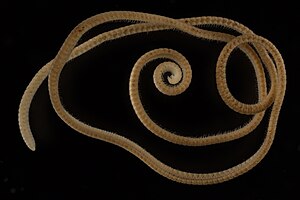Eumillipes persephone
| Eumillipes persephone | ||||||||||||
|---|---|---|---|---|---|---|---|---|---|---|---|---|

Female paratype in the Western Australian Museum |
||||||||||||
| systematics | ||||||||||||
|
||||||||||||
| Scientific name of the genus | ||||||||||||
| Eumillipes | ||||||||||||
| Mark , 2021 | ||||||||||||
| Scientific name of the species | ||||||||||||
| Eumillipes persephone | ||||||||||||
| Mark, 2021 |
Eumillipes persephone is a species of millipede in the family Siphonotidae . It is the only known representative of the 2021 reintroduced genus Eumillipes and was first discovered in 2020 in three drill holes in the Eastern Goldfields of Western Australia . Eumillipes persephone lives underground at depths between 15 m and 60 m.
etymology
The generic name Eumillipes means "true centipede", referring to its number of over 1000 legs; the species epithet Persephone alludes to the eponymous goddess of the underworld , in reference to his subterranean way of life.
description
The eight individuals collected have a body length of up to 95.7 mm and a diameter of 0.95 mm. There are 198 to 330 body segments and up to 1306 legs, making them the most legged species in the known animal kingdom and the first described millipede with 1000 legs or more.
The species has a greatly elongated body with a conical head and unusually large, thick antennae. She is also eyeless, as her subterranean way of life does not require eyes.
The elongated shape, large number of legs, and eyelessness converge with the distantly related species Illacme plenipes , the previous record holder with up to 750 legs. It is believed that the large number of legs helps it move around its underground habitat, allowing it to crawl into small crevices.
The species differs from most suckopods in its elongated shape and thin body, as members of this order are usually shorter, have fewer legs, and have flatter, semi-cylindrical bodies. Belonging to this order is based on analysis of their genome to determine a common ancestor.
way of life
Details of its diet and lifestyle are not known, but it is believed to feed on fungi that grow on the roots of trees.
web links
- Nadja Podbregar: Millipede breaks leg record - Researchers discover world's first millipede with more than a thousand legs - scinexx.de. December 17, 2021, retrieved December 19, 2021 .
- Jan Dönges: 1306 little legs: The first centipede that lives up to its name. In: Spektrum.de. December 16, 2021, retrieved December 22, 2021 .
itemizations
- ↑ a b c d Paul E Marek, Bruno A Buzatto, William A Shear, Jackson C Means, Dennis G Black: The first true millipede—1306 legs long . In: Scientific Reports . tape 11 , No. 1 , December 2021, ISSN 2045-2322 , pp. 23126 , doi : 10.1038/s41598-021-02447-0 ( nature.com [accessed 19 December 2021]).
- ↑ a b Elizabeth Preston: At Last, a True Millipede That Actually Has 1,000 Legs or More . In: The New York Times . December 16, 2021, ISSN 0362-4331 ( nytimes.com [accessed December 19, 2021]).
- ↑ Millipede with more legs than any known animal discovered in Australia . In: BBC News . 16 December 2021 ( bbc.com [accessed 19 December 2021]).
- ↑ a b c d e Nick Kilvert: We have a new world record holder. Introducing the first millipede with more than 1,000 legs. In: amp.abc.net.au. ABC News, December 16, 2021, retrieved December 19, 2021 (Australian English).
- ↑ Donna Lu: The first true millipede: new species with more than 1,000 legs discovered in Western Australia. In: The Guardian. 16 December 2021, retrieved 19 December 2021 (British English).
